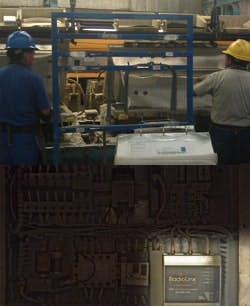Jim Montague is the executive editor for Control. Email him at [email protected].
As long as data is communicated correctly, safely and securely, does it matter if you can't see a wireless network doing its job? Heck no. Likewise, most old-time control engineers never saw their pneumatic valves and relays actuate either, but they still trusted their equipment because they were intimately familiar with how it worked, and very often had installed it themselves. Now, the same is becoming true for wireless.
SEE ALSO: Is Wireless the Right Solution?
Freedom from Wear
The Johnson Controls automotive seat plant in Tlaxcala, Mexico, has 43 carts that move around a carousel as they pass through a urethane process. The line's communication cables that transmit monitoring and control data were wearing out, breaking and causing unplanned downtime. Johnson's engineers needed a more durable, non-intrusive way to establish real-time communications between their carts and supervisory control system, including delivering data to its field office PC and managing permissions on a urethane-injecting robot on the line (Figure 1).
- Wireless Options and Standards
- Wireless To-Do List
System integrator Adepi and distributor Risoul y Cia worked with Tlaxcala's staff, and together they implemented 1743 I/O modules on 23 carts, which were linked via IHN radios and an IHN master that can transfer data at 300 Mpbs to a PLC platform. The I/O modules and PLC are from Rockwell Automation, and the radios are from ProSoft Technology.
"High data-rate radios were the best option for wireless communications between each of the carts and the PLC, based on our testing results and presale technical support provided onsite," says Adrian Torres, Johnson's project leader.
Because the radio-enabled I/O and PLC optimized speed and reduced cable wear on Tlaxcala's urethane-injection process, its remaining carts were scheduled to get wireless components earlier this year. Johnson is also evaluating a similar solution at its U.S. facility.
Move Freely
Besides preventing wear and tear on hardwiring by reducing the need for it in the first place, wireless frees up operators and technicians to move more easily in and around their machines and process applications. It lets them change parameters more directly and efficiently without having to communicate as often with a centralized control room or other detached supervisory stations.
For example, Paper Converting Machine Co. in Green Bay, Wis., had two hardwired HMI pendants mounted on its printing presses and lifts, but it recently added radios to make one HMI wireless. This allows operators to walk around the presses, which makes them easier to set up and adjust while they're running, mostly printing on film or paper for packaging. After adopting an earlier IEEE 802.11 Wi-Fi radio, PCMC migrated to wireless local area network (WLAN) access points and radios from Phoenix Contact. The WLAN also uses Wi-Fi and 200 mW of output power to send 300 Mbps to PLCs on the presses.
"Customers asked for a wireless interface, so in 2010 we integrated fully guarded radios with ranges that weren't too long to monitor channels on the presses. The biggest issue was providing wireless, but we needed communication speeds of 1 second or less, and got 200 ms to 700 ms, which was enough because our monitoring, setup and adjustments don't have to be in real time," says Jordan Koplien, electrical engineer at PCMC, which is a division of Barry-Wehmiller Companies. "The wireless pendant allows operators to see the process web itself, including both sides of the web around its central impression drum, which is a two-sided cylinder with printing heads on each side."
Functionally, PCMC's wireless pendants have all the same capabilities as its regular interfaces, except for e-stops, and run PCMC's proprietary HMI software. They're also Class I, Div. 2-rated for use in potentially explosive environments. "We have reliable communications, but this isn't real-time data, so it's okay to lose a few packets," Koplien adds. "Each user has to decide what he needs for his application. We're not doing critical or safety functions, but wireless is great for general HMI tasks, and it's easy to integrate with the existing Ethernet networking that's on our presses."
Justin Shade, Phoenix Contact's product marketing specialist for wireless, reports that acceptance of wireless is growing in control and automation because so many potential users employ it in consumer devices, and more new devices emerge that make wireless easy to deploy and manage. "Wireless is now second nature in the mainstream," Shade says. "People ask 'My cell phone is reliable, so why shouldn't we do it same way in our plant?' At the same time, tools like Metageek, which is a USB-based spectrum analyzer that can easily test an area for Wi-Fi and other radio frequency (RF) signal types, strengths and interference are coming out. In fact, we added this function to our radios, too."
Figure 1: Operators handle carts on Johnson Controls' urethane-injection production line with help from I/O modules that transmit real-time monitoring data via radios, which receive PC-based control instructions for the line’s urethane-injecting robot.
Freed Up Functions
Beyond reducing cabling and aiding operator flexibility, the great benefit of wireless is that it allows sensing and networking in places that were too small or costly before, which unlocks all kinds of new capabilities and even entirely new applications that were impossible before wireless showed up.
For instance, Wells Concrete relies on process automation to reduce the energy and operating costs of making precast concrete products at its plants in Albany, Minn., and Grand Forks, N.D. Precasting involves pouring concrete into molds or beds and then precisely curing it to maintain hydration of the concrete and sample boxes within a specific temperature range for the greatest strength and durability. Wells previously used analog chart recorders to monitor its 12- to 14-hour curing process and digital controllers to regulate its heat sources, including 300-W light bulbs for the sample box and gas-fired steam boilers or radiant heaters for the concrete beds. The curing process usually took place overnight, and during this time a boiler operator would check for the proper cure temperature and manually close the steam valve if the temperature was satisfactory.
To make its cure process more efficient and save energy costs, Wells worked with Honeywell Process Solutions, which implemented its wireless temperature transmitters, hybrid controller for loop and logic, and SCADA software to monitor and control eight concrete beds and sample boxes in one building at its Albany plant. The wireless temperature transmitters eliminated the need for long thermocouple wiring runs around the concrete beds, cut down on the number of I/O modules required with wired transmitters and simplified the overall control system design. The wireless transmitters reliably and securely transmit up to 2,000 feet with an accuracy of ±0.1% over a three- to five-year battery life.
"With the new control system, bed temperature is monitored and sent from the wireless transmitters to a base unit, which is hardwired to the controller," stated Greg Jacobson, Wells' vice president and general manger. "This temperature reading is used to control the sample box as it was before. However, the current temperature also controls operation of the radiant heater. When the concrete reaches the desired curing temperature, the heater shuts off automatically, and the concrete will hold enough heat to continue the curing process. When the concrete temperature goes below the desired curing temperature, the heater is turned on again."
In addition, Wells applied the same wireless solution to 13 radiant steam beds in a second building at its Albany plant in August 2009. In this case, wireless transmitters still monitor bed temperatures, and sample boxes are controlled by applying a heat source. However, steam valves in the field also are controlled by a wireless gateway that takes an on/off signal from the controller, sends it to various I/O units, and this output request activates a relay that's hardwired to each steam valve's motor actuator. Most recently, Wells tied a Kraft steam generator to the controller to better regulate heat and adopted Honeywell's Experion DCS platform and Vista software.
Thanks to their wireless transmitters and digital controller, Wells operators who used to run their gas heaters for up to 15 hours per concrete bed were able to apply heat to the beds for an average of only three hours, which saved 60% to 70% in energy costs. "Likewise, after only a month of service with the upgraded control system in the second building, we saw a 75% reduction in steam usage and a decrease in labor hours required for production personnel to monitor the bed operation at night," Jacobson adds. "Also, operators at the Albany facility have the automation technology to maintain consistent quality of architectural concrete products, regardless of ambient temperature, humidity and other environmental conditions in the plant."
Amidi Soroush, Honeywell's wireless product marketing manager, reports, "There are now thousands of wireless instruments out there, but not millions, so we still have a long way to go. Fortunately, users are moving from thinking of wireless just a replacement for wires to thinking of wireless as a way to gather new signals and save time. Still, most use wireless for monitoring non-critical, one- to 10-second signals, while critical, 250-millisecond, closed-loop control signals are still usually hardwired."
Free to Decide
Once the many advantages of wireless convince users to adopt it in their applications, there are many guidelines and resources to help them choose the most suitable strategy and devices. Still, because many users are reluctant to try wireless in the first place, some reflexively blame it when early wireless projects struggle with initial problems or growing pains — so patience is another essental requirement.
To select the right radios and supporting components, Phoenix Contact's Shade adds that users need to determine how fast they need their communications to be, how much data they need to process, what they're able to spend and what kind of connection media their environment requires. "Next, they need to work with a local system integrator and supplier, conduct a site assessment of their facility, try out and test a few wireless solutions, and narrow the choice to one or two finalists," he adds. "Finally, they need to work with their integrator to install it, adjust and add more antennas as needed, and maintain it. There's a lot to do the first time you implement wireless, but the second and subsequent times are much easier."
Honeywell's Soroush adds that, "Wireless can be approached like any other control and automation project. Users just need to decide what they're trying to accomplish, evaluate existing equipment, learn how other users employ wireless, pilot and test their own smaller applications, find a wireless solution they like and then roll it out."








